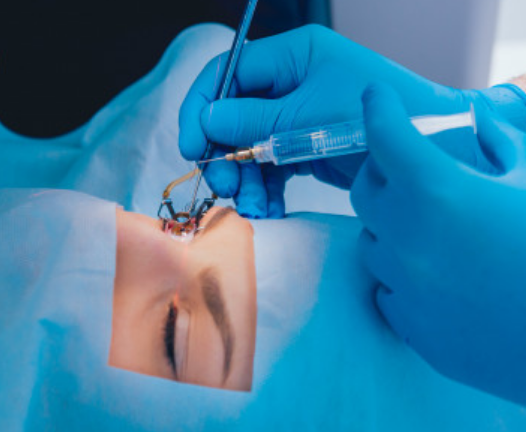LASIK surgeon in Aurangabad
Wadgaonkar Eye Hospital has performed a number of successful Lasik surgeries in Aurangabad since its establishment. We have the Best Lasik Surgeon in Aurangabad in our Hospital & We use the latest instruments eye laser technology to achieve the best surgical results. We follow a strict preoperative check-up procedure at Wadgaonkar Eye Hospital to ensure the candidate’s suitability for Lasik and to prevent any future complications. As a result, we have a 100% success rate in terms of full safety and a 0% postoperative infection rate. Patient protection comes first, backed by an expert team of Eye Specialist in Aurangabad with years of experience and the use of advanced technology. At Wadgaonkar Eye Hospital We have an Expert Cataract surgeon in Aurangabad
What is LASIK eye surgery?
LASIK stands for Laser in Situ Keratomileusis, which means reshaping the cornea (keratomileusis) with a laser under a corneal flap (in situ) . This technique uses an excimer laser, which is a highly advanced laser for treating refractive errors, improving vision, and reducing or eliminating the need for glasses or contact lenses. The cornea, which is the translucent front covering of the eye, is altered by this laser treatment. Though the excimer laser had been used for several years before, Ioannis Pallikaris of Greece is credited with inventing LASIK in 1991.

How does LASIK work?
A specially trained LASIK Surgeon in Aurangabad uses a microkeratome to create a precise, thin hinged corneal flap during the LASIK procedure. After pulling back the flap to reveal the underlying corneal tissue, the excimer laser ablates (reshapes) the cornea in a special pre-specified pattern for each patient. Without sutures, the flap is gently repositioned onto the underlying cornea.
Why it's done
For the correction of one of these vision problems, LASIK surgery may be an option:
- Nearsightedness (myopia). Light rays focus in front of the retina and distort distant vision when the eyeball is slightly longer than average or when the cornea curves too sharply. Objects that are close to you can be seen clearly, but those that are far away cannot.
- Farsightedness (hyperopia). Light focuses behind the retina instead of on it when you have a shorter than normal eyeball or a cornea that is too smooth. This causes blurry vision in the close and far distances.
- Astigmatism is a condition in which a person’s vision is Astigmatism occurs when the cornea bends or flattens unevenly, affecting the orientation of near and far vision.
You probably already wear glasses or contact lenses if you’re considering LASIK surgery. Your eye doctor will discuss whether LASIK surgery or another similar refractive operation will be a good fit for you
there are different types of
LASIK?
In ophthalmology, lasers come in a variety of shapes and sizes. Since all LASIK procedures use the same type of laser (excimer laser), all LASIK procedures are similar in some ways. However, there are a number of laser manufacturers to choose from, including:
- Visx
- Wavelight
- Alcon
- Bausch & Lomb
- Nidek, among others, have all designed specific excimer lasers.
There are also various forms of laser ablations that can be performed (see below), such as traditional laser treatments, wavefront-optimized treatments, and wavefront-guided treatments. Finally, instead of using a mechanical microkeratome to build the LASIK (corneal) flap, a different type of laser (femtosecond laser) may be used.
What are the advantages of LASIK surgery?
In conclusion, LASIK has been shown to be safe and efficient for the majority of people. Most patients would be very happy with their outcomes if they are carefully screened and selected, have realistic expectations, and are under the care of an experienced surgeon. There are some of the additional benefits of LASIK:
- Most degrees of myopia (nearsightedness), hyperopia (farsightedness), and astigmatism can be correctly corrected with LASIK.
- The procedure is quick and painless, typically taking just five to ten minutes.
- The laser is very precise and the results are very accurate since it is guided by a computer.
- In most cases, a single operation is sufficient to produce the desired result; however, enhancements may be made if necessary, often years after the initial surgery.
faq's
In the vast majority of cases, LASIK surgery produces great results. After LASIK surgery, more than 90% of patients are satisfied. However, there are risks associated with this procedure, as with any other operation on the human body.
In the vast majority of situations, you will not require distance glasses following LASIK surgery. You will only need reading glasses when you are the same (or nearly the same) age as you would have been without LASIK surgery.
After LASIK, the majority of people are satisfied with their eyesight after ten years. Over the course of ten years, 35 percent of people who had LASIK needed retreatment, according to one research.
LASIK eye surgery is not painful, fortunately. Your surgeon will put numbing eye drops in both of your eyes right before the procedure. While there may be some pressure during the treatment, you should not experience any pain.
If a patient’s myopia or hyperopia is extremely high, LASIK or ASLA may not be indicated (e.g. level of myopia between -8 and -20 diopters).
